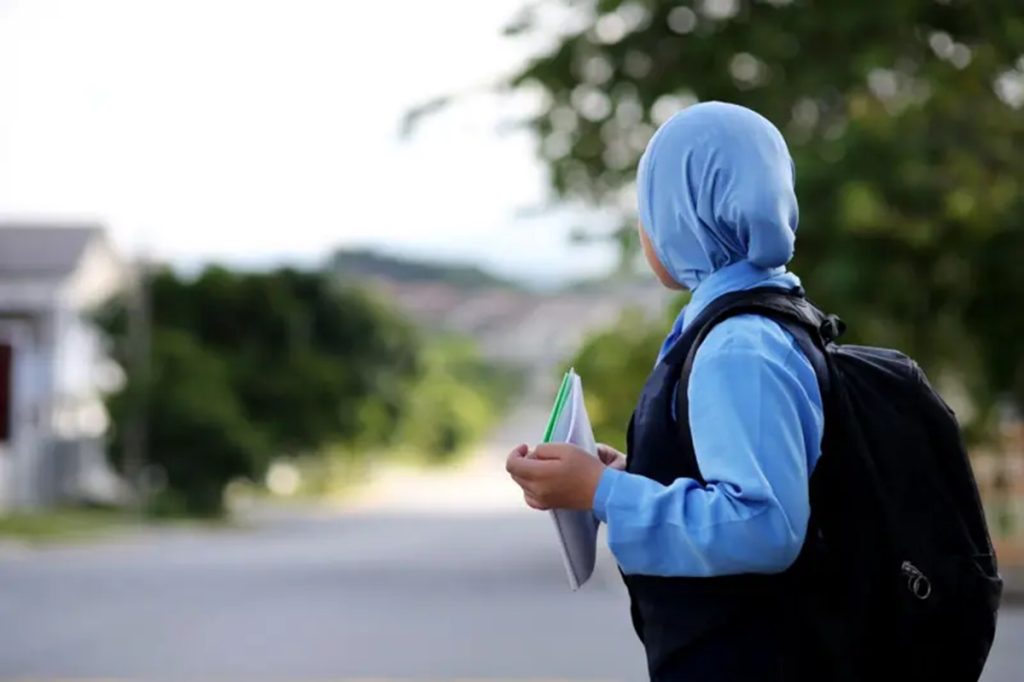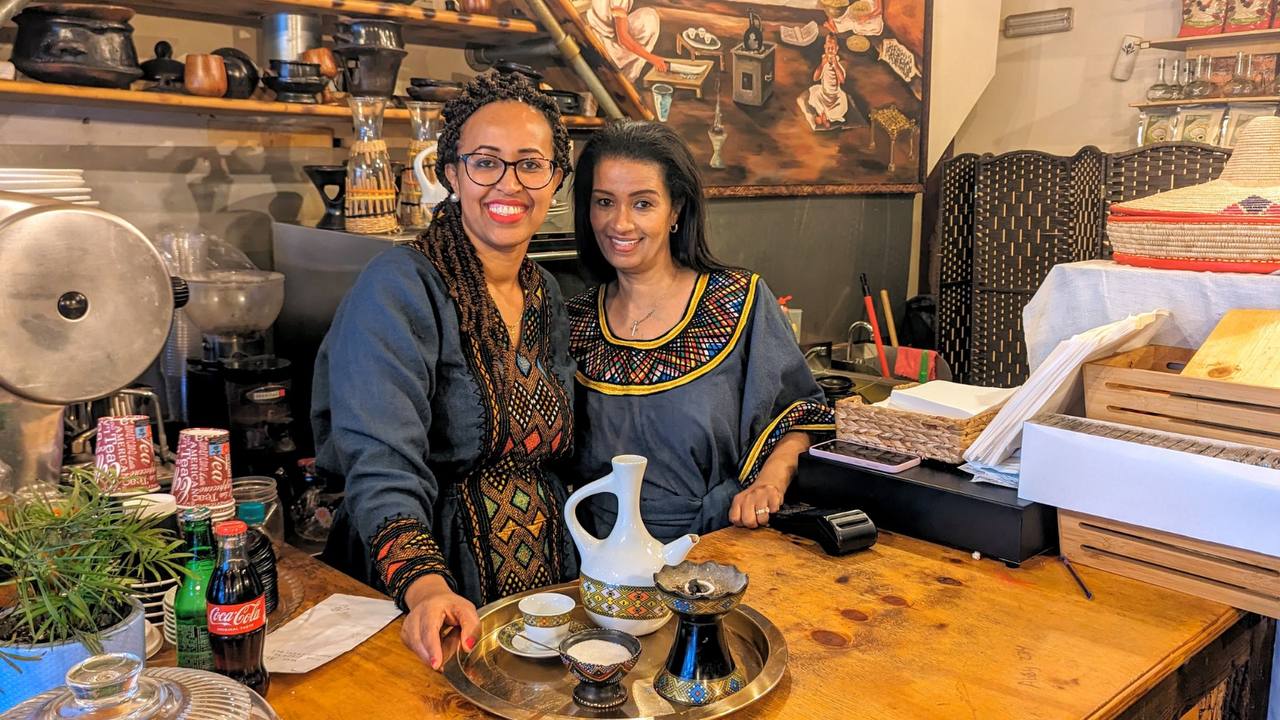(Photo: BBC)
By Kamil Abdu Oumer (PhD)
Addis Abeba – More than 159 Muslim girls in Axum town are going to miss the grade 12 National Examination to be held this academic year due to their hijab, headscarf. In Ethiopian educational institutions, hijab bans on Muslim girls have remained usual actions for educators and officials, and it is not limited to Tigray and Axum. The bans are the sole monopolies of educational institutions, as it is rarely an agenda in hotels, hospitals, airports, banks, and other commercial establishments, parliament, and even for ministerial positions. Many universities throughout the country have expelled many Muslim girls for the mere fact they wear hijab.
A certain Meriem was expelled from Dire Dawa University for wearing hijab while six girls were abducted from Wollo University for 15 days because of hijab, and a whole batch of Muslim girls were forced to abandon their education from Bahir Dar University. This clearly shows that the hijab agenda is a worrisome topic.
The psychological trauma the countless girls in elementary and secondary schools whose headscarves are usually forcefully removed and used as a duster have been going through for years tells a lot. What is more worrisome is that issues that have the potential to distract Muslim students from their focus on their education, including hijab bans, also usually occur at critical times.
Distractors carefully select “the exact time” to distract Muslim girls from their education. They, by design, plan that, though the hijab ban may not be for good, the girls should suffer irreversible loss, like missing exams, missing registration for national exams as it happened for the Axum girls, developing psychological trauma.
The hijab for Muslim women and girls is a religious prescription in the Qur’an. The Qur’an, under Chapter 33 Verse 59 (Surah Al-Ahzab), dictates that “O Prophet, tell your wives and your daughters and the women of the believers to bring down over themselves [part] of their outer garments. That is more suitable that they will be known and not be abused. And ever is Allah Forgiving and Merciful”. The Assembly of Scholars of the Ethiopian Islamic Affairs Supreme Council confirmed that wearing hijab is a mandatory Islamic rule on the ruling (fatwa) it rendered on 01 January, 2025.
Freedom of religion is recognized under the international bill of rights and the Ethiopian Constitution. The FDRE Constitution, particularly provided that the freedom of religion enshrined in the constitutions includes “the freedom, either individually or in community with others, and in public or private, to manifest his religion or belief in worship, observance, practice, and teaching.” This right to manifest one’s religion encompasses “the wearing of distinctive clothing or head coverings,” as General Comment 22 on Article 18 of the ICCPR provides. Thus, there is no doubt that wearing a hijab is part of religious freedom under the existing international and national human rights instruments. Yes, religious manifestations may be limited for the general public good. Limitations on human rights should, however, be justified by the objective to attain legitimate purposes. They should also be proportional and necessary to the needs of the goals and be sanctioned by law.
The usual excuses distractors forward are the need to preserve public culture, the need to maintain secularism, and public security needs, among others. For the cultural argument, having a headscarf is culturally accepted in the majority of the Ethiopian society irrespective of religion, and, even, until recently, brides used to wear veils for their wedding. The public security argument also doesn’t hold water, as hijab has never been an agenda in more sensitive areas like airports.
Finally, secularism in all its versions doesn’t mean calling for abandoning one’s belief unless it is taken as anti-religious secularism. Most of all, if there is a public cause for limiting the wearing of headscarves, it is not the business of individual teachers, school officials, even education bureaus, or the Ministry of Education. Constitutional rights may be limited by law, parliamentary act, or at least by regulation of the Council of Ministers. Village chiefs and line ministries may not limit constitutionally recognized rights through a directive or a circular.
Article 27(5) of the Constitution clearly provides that any limitation on the manifestation of religion should be prescribed by law. Federal Negarit Gazeta Establishment Proclamation No. 3/1995 provides that “all laws of the federal government shall be published in the Federal Negarit Gazeta.” Thus, directives and circulars issued by any organ of the government that are not always published under the Negarit Gazetta do not have the power to limit constitutionally guaranteed rights.
As wearing headscarves is a constitutionally guaranteed liberty that has never been legally limited in Ethiopia, a designed deprivation of such liberties constitutes violence against women. The Declaration on the Elimination of Violence against Women defines violence against women as:
Any act of gender-based violence that results in, or is likely to result in, physical, sexual, or psychological harm or suffering to women, including threats of such acts, coercion, or arbitrary deprivation of liberty, whether occurring in public or in private life.
Similarly, the African Protocol to the African Charter on Human and People’s Rights on the Rights of Women in Africa also defined violence against women as:
All acts perpetrated against women that cause or could cause them physical, sexual, psychological, and economic harm, including the threat to take such acts, or to undertake the imposition of arbitrary restrictions on or deprivation of fundamental freedoms in private or public life in peacetime and during situations of armed conflict or of war;
In both instruments, any measure that deprives or restricts the liberty of women constitutes violence against women. Thus, prohibitions on hijab in educational institutions are a clear form of violence against women. They are gender-based violence against Muslim girls with a deliberate intent to distract them from a hard-earned opportunity to learn.
Ethiopian women have endured multiple challenges in their educational endeavors over the last several years. As any Ethiopian girl, they face all the ugly stigmas, discrimination, and gender-based violence. As part of the Muslim Community, they face challenges peculiar to the Muslim Community. In the pastoral and semi-pastoral areas, they have to pass through additional encumbrances. When they make it to school after all these challenges, expelling them for the mere fact they wear hijab is inhumane.
With all these, this widespread gender-based violence against women has not gained proper attention from any organization working on women’s issues, including the Ministry of Women and Social Affairs, regional bureaus charged with women’s affairs, rights organizations, activities, a considerable number of the media, political parties, etc. The Ministry of Women & Social Affairs and regional bureaus kept silent when 159 girls were forced out of the school in Axum for merely wearing headscarves. All rights groups in Ethiopia, women’s associations, and even the Assembly of the Ethiopian Religious Councils ignored the issue. No rights group, including the Ethiopian Human Rights Commission, has dared to condemn these blatant violations and acts of violence against women. The Ethiopian Human Rights Commission, applauded for daring reports these days, has turned its eyes and ears to this recurrent and blatant violation against women, girls, and children.
Of course, tremendous progress has been made in the fight against the ban on hijabs. The majority of schools and universities are accepting hijab as a casual dressing code for Muslim students. But, still, a considerable number of schools continue to use hijab as a pretext to distract Muslim girls from their education, as it is seen in Axum. Few individuals mad at Islamophobia use the card to deliberately obstruct the hard-earned opportunity to learn.
To protect young girls from this enduring violence, relevant organizations need to play their fair share. The Ethiopian Islamic Affairs Supreme Council should dare to rule on the extent of hijab that young girls are required to wear. The state, in line with its obligation to respect, protect, and fulfill, should discipline its appointees and employees.
Finally, the writer calls for all women’s associations, human rights organizations, governmental organizations mandated to handle women’s affairs at all levels of government, and female members of parliaments (MPs) to come out and call for the end of this violence against girls. AS
Kamil Abdu Oumer (PhD) is an assistant professor of business law at Wollo University School of Law.





